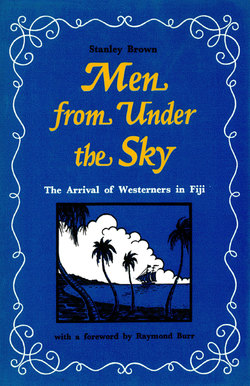Читать книгу Men from Under the Sky - Stanley Brown - Страница 10
На сайте Литреса книга снята с продажи.
ОглавлениеIntroduction
THE ISLANDS of Fiji today are the acknowledged home of many racial groups. These islands have ever been an area where the blood of different races has mixed freely. The first of the island inhabitants to be known to the rest of the world were a mixture of Melanesian and Polynesian stock. The quality of the mixture was largely determined by the geographical position of a man's home island. In the highlands of the larger islands was a rugged dark-skinned race of almost pure Melanesian blood. In the windward islands, and on the coasts of the leeward islands, the people were of strong Polynesian strain. Elsewhere, there was a blood mixture of these two main groups.
Today, in addition to the indigenous Fijians, there live in the islands the people of Caucasian stock known in Fiji as "Europeans," Indians of many racial groups, and Rotumans, Chinese, and representatives of almost all other Pacific island groups. Naturally, all these migrants have caused many changes in the lives of the Fijian people, and in each other's lives. The coming of the Polynesians, mainly from Tonga, had been gradual and spread over many centuries. The other races, except for the indigenous Rotumans, have come to Fiji in the relatively short period of the 19th and 20th centuries. The Europeans were the first of these new groups, and their arrival was a sign that the islands had forever lost their immunity to change.
When the topsails of the ships of this new, strange race lifted over the horizon, the Fijians had no myth or legend to explain either the men or the country from which they came. All could see that the ships came from a place "under the sky," or vavalagi as they called it. The men manning the vessels were christened kai vavalagi or, literally, "men from vavalagi."
These men differed greatly from each other in colour, bearing and character. Although appearing from the same horizon, they hailed from such loosely related areas as the yeoman homes of England, the London slums, the ports of New England, and the penal settlements of New South Wales. The contrasts among them, therefore, are hardly surprising.
The lives of these men in Fiji were to be as unrelated as were their origins. Some robbed and killed. Others came to teach. Some lied and cheated the Fijians out of their land, while at the same time others of the same race were enduring hardships to bring medical and religious benefits to the Fijians. These chapters present a cross section of the men who were to affect the history of Fiji in the first hundred years of the discovery of the islands by the rest of the world. (A few of the first names of persons mentioned in this narrative are missing because they were unrecorded or are unavailable.)
The period also covers the rise of the chieftaincy of Bau, from that of a weak nonentity to the most powerful force in the islands. From it emerged a Fijian proverb: Sa duidui na kaivalagi ("White men are different from each other").
MAP 1 : South Pacific Region
